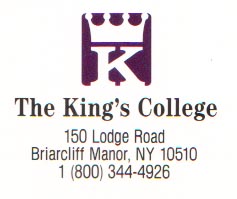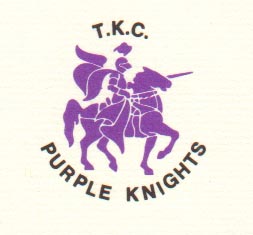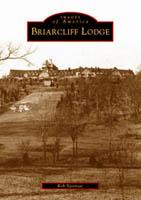The King’s College

Briarcliff Lodge, east front, 1907

Briarcliff Lodge, east front, 1907
Briarcliff Lodge was one of the crown jewels among abandoned buildings in the Hudson Valley. Last used by The King’s College, Briarcliff Lodge actually sat above an entire abandoned campus since its last was open in December 1994. The building stood intact and could have been adaptively reused. Fire on September 20, 2003 destroyed the original 1902 section of the Lodge.
Briarcliff Lodge was built in 1902 as a hotel by Walter W. Law. Law owned much of the surrounding land, on which he had cattle farms and greenhouses. Originally from England, Mr. Law immigrated to the United States in 1858. In 1861 he began working for W & J Sloane. In 1864, Mr. Law was the first person to become a traveling salesman for them. Two years later he became a partner in the company. He suffered a heart attack at age 61, which he recovered from, and “retired” to Westchester by 1901, where he had already begun purchasing land.
The Lodge featured half timber and stucco architecture, called “pseudo-Medieval style” by Frank Sanchis. The original structure was designed by Philadelphia architect Guy King, who was chosen for his designs of many famous country clubs. Mr. King was instructed to create a building that looked less like a hotel and more like a gentleman’s home. A cultivated gentleman’s home, more specifically. If the Ossining Democratic Register is to be believed, this building was the first in the next generation of hotels.
The newspaper article of May 27, 1903 paints a palatial picture of Briarcliff Lodge. The Lodge would have “every convenience, and every device which modern luxury demands. Without it was to be a dream of architectural beauty; within an illustration of the refined and artistic era in which we live.” Briarcliff Lodge was said to be the only hotel in or near New York to provide its guests with long-distance telephone. The power plant below the Lodge originally maintained facilities for sterilizing water for drinking and cooking by heating it to 500 degrees. Originally lit by electricity, the Lodge also contained “a system of suction wheels located in the attic, thus insuring an active ventilation” for the bathrooms and closets. “No other hotel in America has been equipped with this modern system.” The Lodge was managed by a Mr. Arthur Bave, who “will be ably assisted by Mrs. Bave,” the Democratic Register dutifully notes.
The newspaper also makes note of the landscaping of the site. “Situated on one of the most beautiful eminences...six hundred feet above tide water...there is afforded a panorama of the majestic Hudson...three distinct ranges of the lower Catskills...In the foreground...are the estates of...Law...Speyer...Macy...Rockefeller...to be seen in all their natural beauty and perfection. In every direction, as far as the eye can reach, the country is unblemished with factory, town, or anything which would mar the natural attractiveness of the most exclusive region of New York State.” The Olmsted firm designed the grounds, said to have been one of the “most perfect and highly im[proved] park forms in America.”
Briarcliff Lodge
has long been a center of a variety of activities. In its early days as
resort, the Lodge offered popular sports and amenities. It had its own
golf course. The first tee was on the parapet in front of the Lodge, and
the green went down to Dalmeny Road. The original 9-hole course completed a circuit following
the northern boundary of what later became the college campus, with the
ninth hole being where Squire Hall is presently located. The pond below
the hill, actually a tiled pool in the Roman style, was used by the US
Olympic Swimming team for trials in 1924. In 1924, winter Olympic exhibitions were held at Briarcliff Lodge, when a ski jump was constructed outside
the Lodge to Dalmeny Road. Snow shipped from the Adirondacks for the ski jump was
said to contain Canadian whiskey during those Prohibition years. The
greenhouses were famous for their roses (Some of the greenhouse foundations
are visible west of the pond/track area today.) The farm products were
world-renowned, having been commended at the Paris Exposition, and the
water was bottled and sold commercially
The Law family ran
the hotel until 1923, and at that point Chauncey Depew Steele
entered into a twenty-year lease to continue operating the hotel/resort.
Briarcliff Lodge fell on hard times during the Great Depression in the
1930s. In 1936, the Lodge leased out to Dr. Matthew H. Reaser during winter
months to operate the Edgewood Park School, a Christian, non-sectarian
institution. One year later Edgewood Park purchased the property. The Lodge
operated in the summer months through 1939.
Edgewood Park
School combined a college preparatory school for girls with a two
year program “designed to prepare high school gradates for semiprofessional
occupations without neglecting general culture.” The school also
opened its doors to the surrounding community when guest speakers and presenters
visited the campus. One wishes the community today would view Briarcliff
Lodge as a resource to be preserved, shared and enjoyed by all
Edgewood Park
School closed its doors in Briarcliff in 1954 after failing to meet a mortgage
payment. A group of investors looking to restore the glory of the hotel
contracted to but the campus, but a residents lawsuit fought the zoning variance
granting permission to operate a hotel. The case was dismissed in court, as the
judge made the observation that the Lodge was originally a hotel and likely
could only be profitable as such. However, the delay deterred the investors, who
withdrew their plan. In 1955, The King's College bought the Briarcliff Lodge,
it's third home in over fifteen years.
 |
|
 |
The King’s
College is a Christian liberal arts college offering
two and four year programs. Begun in 1938 in New Jersey, the college prospered
in its time in Westchester County. Fully accredited, The King’s College
continued to grow until the early 1980s, when it had an all time high enrollment
of 870 in 1980. Until that time, the college added Squire Hall (gymnasium)
and Miller Circle (dormitory), and in 1979 the Robert Cook Academic / Science
Building. Walter Law’s stone mansion was purchased in 1970, and converted
to men’s dormitories. That building was sold off before the closing of
The King’s College. Six million dollars was raised in 1983 to renovate
and modernize the men’s dorms (rear wing).
Decreasing enrollment in the late 1980s, outmoded buildings and bad financial moves caused the college to close in 1994. Professors unsure of their future had moved on, the school could simply no longer operate. King’s had tried to sell the property, but the town had been used to having the school there (there was no drinking-not legally at least-or partying there, and King’s caused less trouble than other nearby colleges). The village of Briarcliff Manor seemingly blocked every chance of the property being sold, but could do nothing to stop a land-swap. Much help came in the form of Campus Crusade for Christ, several other groups and high-powered alumni, without whose determination there would be no campus at all and The King’s College would have ceased operations entirely. The King’s College traded the Briarcliff campus for a property nearly double the size in Orange County, the former headquarters of International Nickel Corp. On the last day of the 1994 school year, The King’s College received a $100,000 gift, stipulating the college consider moving to New York City. Currently, The King’s College is located on the 15th floor of the Empire State Building, and there are grand plans for the opening of the Tuxedo Campus.
Over the years in Briarcliff, The King’s College acquired several neighboring properties, some through bequests. Braeview (the President’s Home), The Manor House (aka “The Castle,” Walter Law’s stone mansion), and Gronauer Hall were all sold around the time the Briarcliff campus closed. The Tarry Hill campus in Ossining was sold in the early 1980s to raise money for the renovations (desecrations?) to the men’s dorm (1909 wing) of Briarcliff Lodge. Tarry Hill, an old estate, was looted much the same as Briarcliff Lodge. The damage was rumored to have been done by alumnae who once lived there, as the site was planned for demolition.
The closing of The King’s College Briarcliff campus was a saga that developed from a number of factors in the 1970s and 1980s. Alumni, faculty and administrators will agree that the campus did not offer enough to attract new students, and that the Lodge could have received better care and maintenance than it did. The bequests and other donations to the college from community members led to a perception that the village of Briarcliff Manor feels “entitled” to the campus. As related to me by an alumnus,
A former alumnus and administrator put a different spin on the story for me, stating that there were alumni who favored a physical move, being that "Westchester is a very difficult place for a private, poorly endowed institution to survive, say nothing about thrive." A different location would have allowed the College to operate better economically. Touching back to relations between the Village of Briarcliff Manor and The King’s College, the Village hindered development possibilities at the campus. Zoning laws and setback limits denied the college the possibility of new construction, or limited what could be built and where. Some folks associated with the school feel that it "declined rather abruptly during the latter years of the Cook era and that potential for growth and solidification was squandered during the late 1970's and early 80's." In the late 1980s and early 1990s, plans were already underway for a move, and postcards and mailings from that era found inside the abandoned Briarcliff Lodge assert the Blue Lake Campus would be open in September 1992. The Briarcliff Campus, for a variety of reasons, had not been able to expand and attract the number of students necessary to upkeep a large campus of abundant natural beauty and an historic 1902 hotel complex in need of proper upkeep."One of the premier reasons the college died up there was that, the glue that held it together died, Dr. Robert Cook himself. Dr. Cook had been a long-time member of the local fire department and was very well received by the community of Briarcliff Manor. Dr. Radant was not so well received. The Fire Department came in and said the school would need ten million dollars in repairs to the fire alarm system...this would begin the fuel by which Dr. Radant would work to move the campus. Then the town put up a fight. A good many people who I knew in the area said they would have helped if only the President of the college would have addressed them, one of them, a quite famous Lady who wears hats, lives directly across the street from All Saints Episcopal Church....
Believe me when I tell you that there is not an alumnae alive who wanted to see King's move. If Dr. Cook hadn't have died, if he were still alive, and it pains me to say this, the college would still be there, I'm sure of it. But there are serious problems with the buildings,... the water system is a mess and I already told you about the fire system.
We couldn't save Tarry Hill, I doubt very much we'd be able to save Briarcliff Lodge. Besides, the sixties really did a number on the campus, enter orange carpeting and poorly installed sprinkler system. Notice how the pipes are all out in the open...really horrid. Then there is the paneling, and the years and years of shoddy repairs by college employees. Do you see how the paint is peeling on the walls in Women's main, well it has always been like that...they would just make quick repairs and paint over it...Christian groups would come from around the world for the summer and do it...out of charity."
Much like in
the early 1950s, controversy in the village arose over the prospective
use of Briarcliff Lodge after The King’s College closed. A not-for-profit
educational institution known as Tara
Circle entered into agreement with The King’s College in 1992 to purchase
the site. (Tara Circle , dedicated to preserving and promoting Irish culture
and history, has just recently - June 2000 - found a home in Yonkers, NY,
in the Alder Mansion. Alder Mansion was built in 1909 and was the inspiration
of William Boyce Thompson. Alder Mansion also served as the main house
for Elizabeth Seton College. Now after years of disuse Tara Circle will
restore the mansion to its former beauty as a National Historic Landmark.)
Tara Circle’s efforts were later unsuccessful, allegedly due to anti-Irish
sentiment and actions by political representatives of the Village of Briarcliff.
Just like in the 1950s, a
residents' lawsuit protesting the
zoning variance granting Tara Circle permission to hold athletic events and
operate as a not-for-profit deterred investors from joining Tara Circle. In a case
that made it to the U.S. Court of Appeals, Tara Circle’s claims were rejected
by the Court, citing lack of hard evidence of bias and that any alleged
village efforts did not directly interfere with Tara Circle’s efforts.
Even if any alleged efforts from the village or its residents didn’t actually
prevent Tara Circle from acquiring the site, there definitely was an opposition
to an appropriate use of the site. Many people seemed concerned about the
size of the project, but if anything is to work up there, it has to be
fairly sizable. This rejection I find strange, especially the proposed
uses were in line with the original uses of a site that has been around
for nearly one hundred years.
The Briarcliff
Lodge and the surrounding property was owned by Blue Lake Properties, LLC, as a
result of the land-swap with The Kings College. This company had no stake in the
building while it stood vacant, only waiting to collect on the payout that would
come once the village approved a plan to redevelop the site. The plan that was
approved was that of Barrington Venture, LLC, an Illinois firm that plans a
Continuing Care Retirement Community on the site of the old Lodge.
A spokesman for Barrington Venture said they explored the
possibility of saving the Lodge for use as a hotel, but was told by the mayor of
the village that no hotel could be opened on the site. They plan they outlined
in the environmental impact statement was to demolish all buildings and in their
place erect modern substitutes. This plan was approved in 2003. The abatement of
hazardous materials, such as lead and asbestos, to be followed by demolition of
existing structures, was scheduled to begin Wednesday September 24, 2003. This
process would have been an expensive and time-consuming task for the developer.
(The building first had to be abated. Once certified, the demolition permits
would then allow Barrington Venture to remove the building entirely. This
process was scheduled to last until December 31, 2003.)
In the early morning hours of Saturday, September 20, 2003, a
fire broke out in the 1902 section of Briarcliff Lodge. This wood-frame section
was entirely destroyed within hours. The first fire
crews were on the scene at 6:45 am. The fire may have been smoldering for
several hours, although I was told by a firefighter that a security guard making
rounds of the property did not report anything suspicious at 5am. By
mid-afternoon, all that was left of the original section was the ground level
stone facade and the brick chimneys. Those were demolished later in the night by
a demolition crew. The 1906 north wing, built of concrete and in the same
architectural style as the original Lodge, and the 1909 rear tower addition, all
survived the fire, but the fire perhaps sped up their demolition schedule.
Subsequently, all of the buildings on the property were
demolished. Eventually, Barrington Venture sold the property to Classic
Residence by Hyatt. After all the years of planning, Barrington decided it was
not worth their while to build in Briarcliff Manor. Hyatt too left town, in
August 2006, without building anything on the site except for a temporary sales
office. So the village of Briarcliff Manor, whose officials were so supportive
of the proposed redevelopment plans and steadfast in their desire to see the
great Briarcliff Lodge disappear, has been left standing at the altar. At least
those who were vocal in their opposition to "traffic, noise and
congestion" got their way. There is, for now, a quiet, 58-acre
"preserve" in the middle of the community.
To see photographs of the Briarcliff Lodge and the former
campus of the Kings College, as it was before all buildings were demolished,
visit the homepage
for this site.
 The Briarcliff Lodge book Ordering details |
Yaz’ Hudson Valley Ruins and Abandoned Buildings, etc.
|
This page copyright © 2000 by Robert J.Yasinsac. All rights reserved. Reproduction or copying of these photos in any form is not permitted.